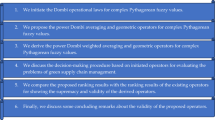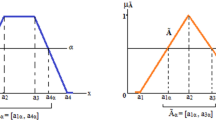Abstract
A conventional LASSO (least absolute shrinkage and selection operator) regression model utilizing the Pythagorean fuzzy sets in a system reliability analysis is developed. Overall, the Pythagorean fuzzy multivariate regression analysis enables decision makers to correctly identify the relationships between a set of responses in the form of fuzzy or non-fuzzy interpretive variables. The interpretability of the model is significantly improved by the proposed Pythagorean fuzzy LASSO regression model (PFLRM). Thus, a system reliability analysis is considered as an application of the study to evaluate the efficiency and effectiveness of the proposed PFLRM. There is no doubt that a system reliability analysis is vital to improve the safety performance of chemical processing industries, where an extensive number of industrial accidents occur annually. These accidents have subsequently highlighted the failure of some of the intervention actions to keep the systems safely in operation. The results illustrate a better performance with higher accuracy with the proposed PFLRM compared with the existing number of fuzzy regression models, particularly in the availability of non-informative variables.
















Similar content being viewed by others
Abbreviations
- CV:
-
Validation criterion
- FLRM:
-
Fuzzy linear regression method
- HFACS:
-
Human factor analysis and classification system
- IFN:
-
Intuitionistic fuzzy numbers
- IFS:
-
Intuitionistic fuzzy set
- LASSO:
-
Least absolute shrinkage and selection operator
- MARE:
-
Absolute relative error
- OI:
-
Organizational influences
- PFLRM:
-
Pythagorean fuzzy LASSO regression model
- PFN:
-
Pythagorean fuzzy numbers
- PFS:
-
Pythagorean fuzzy set
- PUA:
-
Preconditions for unsafe acts
- RMSE:
-
Root mean square error
- SF:
-
Supervisory factors
- SM:
-
Similarity measure
- UA:
-
Unsafe acts
References
Yazdi M, Adesina KA, Korhan O, Nikfar F (2019) Learning from fire accident at bouali sina petrochemical complex plant. J Fail Anal Prev. https://doi.org/10.1007/s11668-019-00769-w
Aleixandre-Tudó JL, Alvarez I, García MJ, Lizama V, Aleixandre JL (2015) Application of multivariate regression methods to predict sensory quality of red wines. Czech J Food Sci 33:217–227. https://doi.org/10.17221/370/2014-CJFS
Hesamian G, Akbari MG (2019) Fuzzy Lasso regression model with exact explanatory variables and fuzzy responses. Int J Approx Reason 115:290–300. https://doi.org/10.1016/j.ijar.2019.10.007
Yazdi M (2019a) A perceptual computing—based method to prioritize intervention actions in the probabilistic risk assessment techniques. Qual Reliab Eng Int. https://doi.org/10.1002/qre.2566
Fan J, Li R (2001) Variable selection via nonconcave penalized. J Am Stat Assoc 96:1348–1360
Zhang CH (2010) Nearly unbiased variable selection under minimax concave penalty. Ann Stat. https://doi.org/10.1214/09-AOS729
Tibshirani R (1996) Regression shrinkage and selection Via the Lasso. J R Stat Soc Ser B 58:267–288. https://doi.org/10.1111/j.2517-6161.1996.tb02080.x
Meier L, Van De Geer S, Bühlmann P (2008) The group lasso for logistic regression. J R Stat Soc Ser B Stat Methodol 70:53–71. https://doi.org/10.1111/j.1467-9868.2007.00627.x
Meinshausen N, Yu B (2009) Lasso-type recovery of sparse representations for high-dimensional data. Ann Stat 37:246–270. https://doi.org/10.1214/07-AOS582
Tibshirani R, Saunders M, Rosset S, Zhu J, Knight K (2005) Sparsity and smoothness via the fused lasso. J R Stat Soc Ser B Stat Methodol 67:91–108. https://doi.org/10.1111/j.1467-9868.2005.00490.x
Tanaka H, Uejima S, Asai K (1982) Linear regression analysis with Fuzzy model. IEEE Trans Syst Man Cybern 75:903–907
Yazdi M, Nedjati A, Abbassi R (2019) Fuzzy dynamic risk-based maintenance investment optimization for offshore process facilities. J Loss Prev Process Ind 57:194–207. https://doi.org/10.1016/J.JLP.2018.11.014
Hesamian G, Akbari MG, Asadollahi M (2017) Fuzzy semi-parametric partially linear model with fuzzy inputs and fuzzy outputs. Expert Syst Appl 71:230–239. https://doi.org/10.1016/j.eswa.2016.11.032
Chachi J, Roozbeh M (2017) A fuzzy robust regression approach applied to bedload transport data. Commun Stat Simul Comput 46:1703–1714. https://doi.org/10.1080/03610918.2015.1010002
Alfonso G, de Hierro AFRL, Roldán C (2017) A fuzzy regression model based on finite fuzzy numbers and its application to real-world financial data. J Comput Appl Math 318:47–58. https://doi.org/10.1016/j.cam.2016.12.001
Li J, Zeng W, Xie J, Yin Q (2016) A new fuzzy regression model based on least absolute deviation. Eng Appl Artif Intell 52:54–64. https://doi.org/10.1016/j.engappai.2016.02.009
De Hierro AFRL, Martínez-Moreno J, Aguilar-Peña C, De Hierro CR (2016) Estimation of a fuzzy regression model using Fuzzy distances. IEEE Trans Fuzzy Syst 24:344–359. https://doi.org/10.1109/TFUZZ.2015.2455533
Chachi J, Taheri SM (2016) Multiple fuzzy regression model for fuzzy input-output data. Iran J Fuzzy Syst 13:63–78. https://doi.org/10.22111/ijfs.2016.2596
Jung HY, Yoon JH, Choi SH (2015) Fuzzy linear regression using rank transform method. Fuzzy Sets Syst 274:97–108. https://doi.org/10.1016/j.fss.2014.11.004
Zeng W, Feng Q, Li J (2017) Fuzzy least absolute linear regression. Appl Soft Comput J 52:1009–1019. https://doi.org/10.1016/j.asoc.2016.09.029
Kelkinnama M, Taheri SM (2012) Fuzzy least-absolutes regression using shape preserving operations. Inf Sci (Ny) 214:105–120. https://doi.org/10.1016/j.ins.2012.04.017
Lee WJ, Jung HY, Yoon JH, Choi SH (2015) The statistical inferences of fuzzy regression based on bootstrap techniques. Soft Comput 19:883–890. https://doi.org/10.1007/s00500-014-1415-5
Stehlík M, Economou P, Papić L, Aronov J, Nicolis O, Antoch J, Cézová E, Kiseľák J (2018) Statistical testing of availability for mining technological systems with air quality constraints. Appl Stoch Model Bus Ind 34:278–292. https://doi.org/10.1002/asmb.2337
Zadeh L (1965) Fuzzy sets. Inf Control 8:338–353
Yazdi M, Daneshvar S, Setareh H (2017) An extension to fuzzy developed failure mode and effects analysis ( FDFMEA ) application for aircraft landing system. Saf Sci 98:113–123. https://doi.org/10.1016/j.ssci.2017.06.009
Atanassov KT (1986) Intuitionistic fuzzy sets. Fuzzy Sets Syst 20:87–96. https://doi.org/10.1016/S0165-0114(86)80034-3
Deng Y (2012) D numbers: theory and applications background knowledge. J Inf Comput Sci 9:2421–2428
Yager RR (2014) Pythagorean membership grades in multicriteria decision making. IEEE Trans Fuzzy Syst 22:958–965. https://doi.org/10.1109/TFUZZ.2013.2278989
Peng X, Selvachandran G (2019) Pythagorean fuzzy set: state of the art and future directions. Artif Intell Rev 52:1873–1927. https://doi.org/10.1007/s10462-017-9596-9
Zadeh LA (2015) Fuzzy logic—A personal perspective. Fuzzy Sets Syst 281:4–20. https://doi.org/10.1016/j.fss.2015.05.009
Xu Z, Yager RR (2006) Some geometric aggregation operators based on intuitionistic fuzzy sets. Int J Gen Syst 35:417–433. https://doi.org/10.1080/03081070600574353
Zhang X, Xu Z (2014) Extension of TOPSIS to multiple criteria decision making with pythagorean fuzzy sets. Int J Intell Syst 29:1061–1078. https://doi.org/10.1002/int.21676
Yager RR (2013) Pythagorean fuzzy subsets, In: 2013 Jt. IFSA World Congr. NAFIPS Annu. Meet., IEEE, 2013, pp. 57–61. https://doi.org/10.1109/IFSA-NAFIPS.2013.6608375
Yazdi M, Khan F, Abbassi R, Rusli R (2020) Improved DEMATEL methodology for effective safety management decision-making. Saf Sci 127. https://doi.org/10.1016/j.ssci.2020.104705
Yazdi M (2019b) Acquiring and sharing tacit knowledge in failure diagnosis analysis using intuitionistic and pythagorean assessments. J Fail Anal Prev. https://doi.org/10.1007/s11668-019-00599-w
Peng X, Yang Y (2014) Some results for pythagorean fuzzy sets. Int J Intell Syst 29:495–524. https://doi.org/10.1002/int
Yu X, Xu Z (2013) Prioritized intuitionistic fuzzy aggregation operators. Inf Fusion 14:108–116. https://doi.org/10.1016/j.inffus.2012.01.011
Chen T (2019) Multiple criteria group decision making using a parametric linear programming technique for multidimensional analysis of preference under uncertainty of pythagorean fuzziness. IEEE Access 7:174108–174128. https://doi.org/10.1109/ACCESS.2019.2957161
Zhou L, Dai G, Qin R, Tang M, Qiu J (2018) Risk analysis of gob coal spontaneous combustion in methane-rich, combustion-prone coal seam based on intuitionistic Fuzzy DEMATEL. J Fail Anal Prev 18:975–987. https://doi.org/10.1007/s11668-018-0492-7
GAMS (2020) https://www.gams.com. Accessed 16 Jan 2020
H. Department (2016) Bouali Sina Fire Accident Report, Mahshahr
Shappell SA, Wiegmann DA (2000) Applying Reason: the human factors analysis and classification system (HFACS). Hum Factors Aerosp Saf An Int J 1:59–86
Rausand M (2011) Risk assessment: theory methods and applications. Wiley, New York
Yazdi M (2019c) Introducing a heuristic approach to enhance the reliability of system safety assessment. Qual Reliab Eng Int 35:1–27. https://doi.org/10.1002/qre.2545
Daneshvar S, Yazdi M, Adesina KA (2020) Fuzzy smart failure modes and effects analysis to improve safety performance of system: case study of an aircraft landing system. Qual Reliab Eng Int 36:1–20. https://doi.org/10.1002/qre.2607
Yazdi M, Hafezi P, Abbassi R (2019) A methodology for enhancing the reliability of expert system applications in probabilistic risk assessment. J Loss Prev Process Ind 58:51–59. https://doi.org/10.1016/j.jlp.2019.02.001
Yazdi M (2018) Footprint of knowledge acquisition improvement in failure diagnosis analysis. Qual Reliab Eng Int 35:1–18
Yazdi M (2019d) Ignorance-aware safety and reliability analysis: a heuristic approach. Qual Reliab Eng Int 36:652–674. https://doi.org/10.1002/qre.2597
Kula KŞ, Apaydin A (2008) Fuzzy robust regression analysis based on the ranking of fuzzy sets. Int J Uncertain Fuzz Knowl Based Syst 16:663–681. https://doi.org/10.1142/S0218488508005558
Choi SH, Yoon JH (2010) General fuzzy regression using least squares method. Int J Syst Sci 41:477–485. https://doi.org/10.1080/00207720902774813
Sugeno M (1985) An introductory survey of fuzzy control. Inf Sci (Ny) 36:59–83. https://doi.org/10.1016/0020-0255(85)90026-X
Choi SH, Buckley JJ (2008) Fuzzy regression using least absolute deviation estimators. Soft Comput 12:257–263. https://doi.org/10.1007/s00500-007-0198-3
Taheri SM, Kelkinnama M (2012) Fuzzy linear regression based on least absolutes deviations. Iran J Fuzzy Syst 9:121–140. https://doi.org/10.22111/ijfs.2012.230
Yazdi M (2019e) A review paper to examine the validity of Bayesian network to build rational consensus in subjective probabilistic failure analysis. Int J Syst Assur Eng Manag. https://doi.org/10.1007/s13198-018-00757-7
Yazdi M, Kabir S, Walker M (2019) Uncertainty handling in fault tree based risk assessment: state of the art and future perspectives. Process Saf Environ Prot 131:89–104. https://doi.org/10.1016/j.psep.2019.09.003
Park T, Casella G (2008) The bayesian lasso. J Am Stat Assoc 103:681–686. https://doi.org/10.1198/016214508000000337
Author information
Authors and Affiliations
Corresponding author
Ethics declarations
Conflict of interest
The authors declare that they have no known competing financial interests or personal relationships that could have appeared to influence the work reported in this paper.
Additional information
Publisher's Note
Springer Nature remains neutral with regard to jurisdictional claims in published maps and institutional affiliations.
Rights and permissions
About this article
Cite this article
Yazdi, M., Golilarz, N.A., Nedjati, A. et al. An improved lasso regression model for evaluating the efficiency of intervention actions in a system reliability analysis. Neural Comput & Applic 33, 7913–7928 (2021). https://doi.org/10.1007/s00521-020-05537-8
Received:
Accepted:
Published:
Issue Date:
DOI: https://doi.org/10.1007/s00521-020-05537-8




